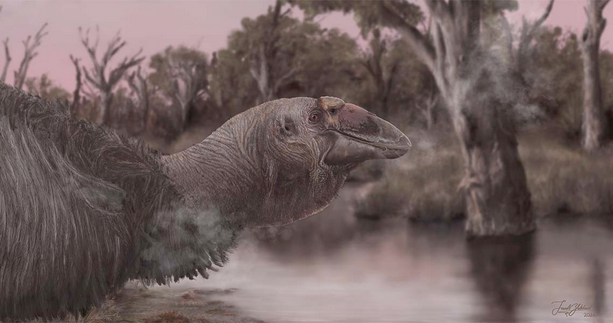If you're a Pal-level subscriber at Defector, you get access to a premium weekday newsletter called The Cipher, which has a recap of the blog day, links to other sites, and extra takes and bits from staffers. You can change your newsletter preferences or upgrade your subscription at the My Account page. Here, from the newsletter archives, is a Creature Drop from Creaturefector's Sabrina Imbler.
Although the bird Genyornis newtoni had stubby wings and could not fly, it was enormous—standing over six feet tall and weighing between 485 and 530 pounds. It had powerful hind legs and toes like hoofs. And though the species went extinct around 45,000 years ago, cave paintings and fossil footprints suggest the bird spent its last 15,000 years on Earth terrorizing the first Australians. Now, a new paper in Historical Biology puts a horrible face to this prehistoric horrible goose.
The only other skull ever found of the species, discovered in 1913, was heavily damaged by salt crystals and broken by a nuisance of rabbits. But researchers from Flinders University found new fossilized skulls in the dry lake beds of Lake Callabonna in Southern Australia—a treasure trove of fossilized megafauna that has likely been known to indigenous peoples for a long time, a researcher told Gizmodo. The researchers discovered the skull in 2019 alongside nearly complete fossils of the huge bird. The individual appeared to have run into the mud of its lake, broke its leg, fell over, and died, the researchers told Science. “With this new skull we have started to piece together the puzzle which shows, simply put, this species to be a giant goose,” researcher Phoebe McInerney said in a press release. “For the first time we could put a face on this bird, one very different to any other bird, yet like a goose,” researcher Trevor Worthy said in the release.
G. newtoni is not exactly a goose, taxonomically speaking. But its face resembles one, hence the nickname “giga-goose.” Its upper jaw was tall and mobile like a parrot’s but was shaped like a goose’s—long and with a goose-like rounded tip. G. newtoni would have been able to open its mouth wide and bite hard on fruits and other plants. It belongs to a family called Dromornithidae, which contains landfowl like chickens and quails and waterfowl like ducks and geese. The closest living relative of this giga-goose is Anhima cornuta, a bird also called the horned screamer because it has a very loud and repetitive scream.
Although this giga-goose would have certainly been a terror to its neighbors, the first Australians stole and feasted on its large and tasty eggs. This exploitation may have contributed to the giga-goose’s eventual demise. But in this giga-goose’s heyday, stomping around wetlands and lakes with its hoof-like claws, G. newtoni was the king of its swamp—very different to any other bird, yet very much like a goose.
Thank you for your continued support of Defector! See you later.






